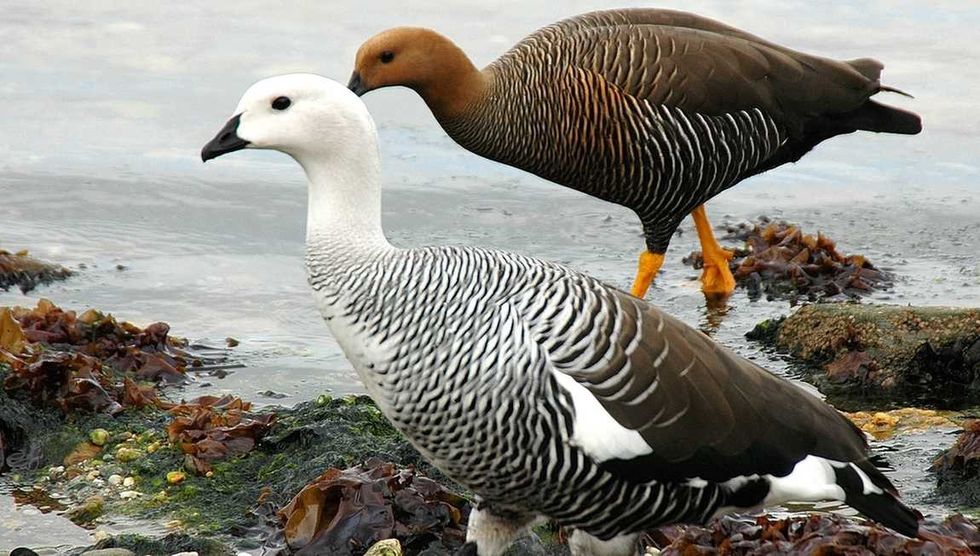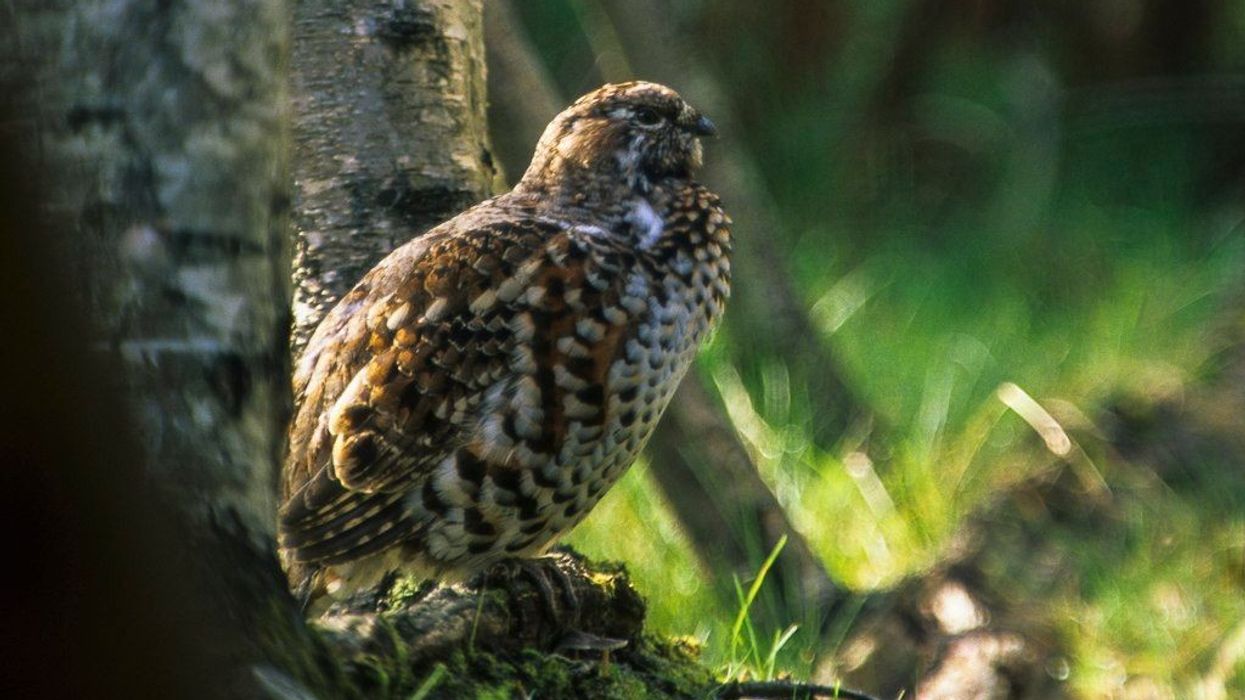The upland goose is a type of sheldgoose. Also called the Magellan goose, Chloephaga picta is a member of the Anatidae family.
These big birds have a wide range with their population mainly spotted in South America. It is important to note that the physical description of male and female birds is not the same!
Adult birds of both sexes have different hued bodies. Adult males walk around with a white breast and head and have dark gray tinted feathers on their wings. In contrast to the males, females have an overall brown body with random black stripes on feathers.
You can always spot this bird feeding on grass, leaves, berries, or other plant matter. There are two subspecies of this bird which you can learn about below.
For more relatable content, check out these swan goose facts and nene goose facts for kids.
Upland Goose Interesting Facts
What type of animal is an upland goose?
The upland goose or Magellan goose is a type of sheldgoose.
What class of animal does an upland goose belong to?
The upland goose or Magellan goose (Chloephaga picta) belongs to the class Aves.
How many upland geese are there in the world?
We do know the total population of the upland geese. However the IUCN gave this species a status of Least Concern which means their numbers are currently stable and these birds are not facing any significant threats.
Where does an upland goose live?
Upland geese, or Magellan goose, have their population distributed across a wide range from Chile and Argentina, all the way to Tierra del Fuego. A distinct population is also spotted on a beautiful, remote South Atlantic archipelago called the Falkland Islands (Islas Malvinas). There have also been sightings of a small population of upland geese on South Georgia Island.
What is an upland goose's habitat?
The upland goose habitat consists of lowland scrubs, pastures, temperate grasslands, and even agricultural lands. Some specimens have also been spotted in open mountains. They prefer altitudes ranging from sea level up to a level of 4921 ft (1500 m).
Those residing on the Falkland Islands prefer coastal meadows and grassy islands.
Who do upland geese live with?
All geese species prefer staying in large groups. A group of geese has a funny name, it is called a gaggle.
How long does an upland goose live?
We do not know the lifespan of the upland goose or Magellan goose. However, the average life expectancy of a goose bird is about 15-20 years.
How do they reproduce?
Upland geese prefer breeding in plains or densely vegetated lands. The mating season is mainly concentrated between the months of September to October, or even November on the beautiful Falkland Islands.
Upland geese relationships are monogamous. A special courtship ritual is carried out, where the males try to capture the attention of female geese. They whistle loudly at the females, to which female geese answer with cackles. Breeding takes place in solitary pairs or in large loose colonies.
The nest is built on the ground and well hidden between dense vegetation. The location of the nest is quite close to the water. A female upland goose lays about five to eight eggs in a clutch.
Incubation duties are carried out for almost an entire month. When the eggs hatch open, the chicks are fully covered in gray-brown down.
Immediately after birth, these chicks are able to leave their nests and walk down to the neighboring water body. They begin feeding themselves immediately and it takes about two to three months for the chicks to fledge completely. They mature around the age of three years.
What is their conservation status?
The conservation status of the upland goose (Chloephaga picta) is Least Concern.
Upland Goose Fun Facts
What does an upland goose look like?
The physical description of an adult male upland goose begins with its body color. An adult male has a bright white head and breast.
Upperparts are off gray with multiple white bars and the rump and rectrices are blackish. On the male’s inner secondary flight feathers, a green-bronze patch is present. The male also has a black bill, legs, webbed feet, and black irises.
On the other hand, a female goose has an oak-brown body and its wings have black stripes on them. The female goose has yellow webbed feet, unlike the male. The iris is dark brown and the bill is a black hue.
How cute are they?
Magellan geese can be considered quite cute, especially the baby goslings with their gray-brown down. However, adult geese are known to be aggressive.
How do they communicate?
Adult male birds of this species make loud dragged whistles, whereas the adult female makes softer cackles.
How big is an upland goose?
The body length of the upland goose is about 23.5-29 in (60-73.6 cm). This makes them about five times the size of the vermilion flycatcher.
How fast can an upland goose fly?
We do not have the speed at which the upland goose (Chloephaga picta) can fly. In general, geese are heavy birds and have a maximum speed of 30 mph (48 kph). They use their large, powerful wing beats to fly, rather than glide like birds of prey.
How much does an upland goose weigh?
The birds of this species weigh between 6-7.2 lb (2.72-3.26 kg).
What are the male and female names of the species?
Generally, a male goose is called a gander and a female goose is called a dame.
What would you call a baby upland goose?
Young birds of this species are called goslings.
What do they eat?
The upland goose diet is entirely herbivorous. They have been seen feeding on aquatic plants, sedges, leaves, stems, grass, seeds, and other plant matter. They are also known to feed on pastures in agricultural fields, often being the cause of the destruction of important crops.
Are they dangerous?
Male geese can be pretty defensive of their partners and territories. If a male upland goose enters the territory of another upland goose, a fight will break out between the birds which often leads to dangerous injuries or it could be fatal.
Would they make a good pet?
We do not think the upland goose or Magellan goose would make a good pet as it prefers staying close to its natural marine habitats. Also, male geese are known to be aggressive and attack other animals as well as humans if they feel threatened.
Did you know...
This bird of the Anatidae family has two subspecies under it. The mainland subspecies which are smaller in size is the lesser Magellan goose (Chloephaga picta picta).
The range of this bird's population is distributed from Argentina, Chile to South America’s southernmost tip, Tierra del Fuego. The other species which is indigenous to the beautiful Falkland Islands is the greater Magellan goose (Chloephaga picta leucoptera).
What are the different types of geese?
Geese are generally classified into three types, heavy, medium, and light geese. Heavy geese breeds constitute the Toulouse, African, and Embden geese. The breeds falling under the medium goose classification are pilgrim, American buff, Sebastopol, Steinbacher, bean, and Pomeranian. The light goose breeds include the tufted Roman, Egyptian, Canada goose, and Chinese goose.
Here at Kidadl, we have carefully created lots of interesting family-friendly animal facts for everyone to discover! Learn more about some other birds from our Toulouse goose facts and snow goose facts pages.
You can even occupy yourself at home by coloring in one of our free printable Canada goose coloring pages.









